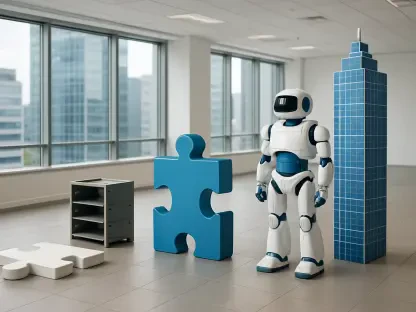Imagine stepping into a lively office at 9:45 a.m., where the air is thick with the sound of ringing phones, overlapping Zoom calls, and constant chatter among colleagues, creating a scene that radiates productivity and collaboration for many. However, for neurodivergent individuals—comprising an estimated 15-20% of the population—this environment can be an overwhelming sensory trap. Neurodiversity includes conditions such as autism, ADHD, and dyslexia, often bringing heightened sensitivity to noise, light, or crowded environments. Traditional office setups, with their open-plan layouts and intense lighting, frequently fail to accommodate these needs, leaving many employees struggling to focus or feel at ease. This isn’t merely a personal issue; it’s a systemic barrier that limits individual potential and organizational growth. Exploring how workplaces can adapt to embrace neurodiversity is not just about equity—it’s about harnessing diverse talents for innovation. This discussion delves into actionable strategies and cutting-edge approaches to create truly inclusive environments.
Uncovering the Barriers in Traditional Office Settings
The design of conventional offices often prioritizes a one-size-fits-all approach, emphasizing collaboration through vast open spaces and dynamic atmospheres that can inadvertently alienate neurodivergent employees. Bright fluorescent lights, unrelenting background noise, and the absence of secluded areas for respite can trigger sensory overload, making it challenging to concentrate or maintain well-being. For someone with heightened sensory perception, the clatter of keyboards or the hum of conversations isn’t just a minor distraction—it can be a profound hindrance to productivity. These environmental factors create a daily struggle, where the lack of quiet zones or adjustable settings forces individuals to expend extra energy just to cope with their surroundings. Addressing these design flaws is critical, as they not only affect personal performance but also signal a broader failure to recognize diverse needs within the workforce, ultimately impacting the inclusivity of the workplace culture.
Beyond the immediate sensory challenges, the implications of unsuitable office environments extend to deeper issues of mental health and job satisfaction for neurodivergent individuals. Constant exposure to overstimulating spaces can lead to stress, anxiety, or burnout, as the effort to navigate these settings takes a significant emotional toll. This often results in disengagement or higher turnover rates, as employees may feel misunderstood or unsupported in their unique ways of processing the world. The business cost of this oversight is substantial—losing talent means losing valuable perspectives that could drive creative solutions and enhance team dynamics. Moreover, the lack of tailored spaces sends a message that only certain working styles are valued, undermining efforts to build a diverse and equitable workplace. Recognizing and mitigating these long-term effects is essential for fostering an environment where every employee has the opportunity to thrive without unnecessary barriers.
Harnessing Digital Tools for Tailored Environments
Technology is paving the way for revolutionary changes in workplace design, offering solutions that cater to the diverse needs of neurodivergent employees through data-driven insights. Advanced digital tools, such as agent-based modeling software and machine learning algorithms, enable designers to simulate human interactions within a given space before construction even begins. By inputting data on sound levels, movement patterns, and spatial configurations, these systems can identify potential stressors—like areas prone to excessive noise or visual clutter—and suggest modifications to alleviate them. This approach ensures that environments are not only functional but also supportive, creating layouts that minimize sensory overload while maintaining a balance for all employees. The precision of such technology marks a shift from generic office planning to customized designs that prioritize accessibility and comfort for neurodivergent individuals.
The real strength of these technological advancements lies in their predictive and adaptable nature, allowing for continuous improvement in workplace inclusivity. Virtual simulations can test multiple design scenarios, assessing how different lighting options or acoustic treatments might impact someone with sensory sensitivities. Adjustments can be made in the planning phase to include features like soundproof pods or dimmable lights, preventing costly retrofits later. Additionally, machine learning can integrate feedback over time, refining spaces as employee needs evolve or as new data emerges about effective design for neurodiversity. This proactive method contrasts sharply with traditional trial-and-error approaches, offering a scalable framework that companies can apply across various locations. By embedding such tools into the design process, businesses can create environments that not only meet current standards of inclusivity but also anticipate future needs, ensuring long-term benefits for their workforce.
Emphasizing Collaboration and Lived Experiences
While technology provides a robust foundation for inclusive design, the human perspective remains indispensable in ensuring workplaces genuinely serve neurodivergent individuals. The guiding principle of “nothing about us without us” underscores the necessity of involving those directly affected in the creation of their environments. Engaging neurodivergent employees in discussions about layout preferences, sensory triggers, and functional needs ensures that solutions are grounded in reality rather than speculation. For instance, feedback on the placement of quiet zones or the texture of materials can reveal insights that data alone might miss. This collaborative process respects the autonomy of individuals and validates their experiences, fostering a workplace culture that values every voice. Such participation not only enhances the relevance of design choices but also builds trust between employees and employers, reinforcing a shared commitment to equity.
The benefits of this human-centered approach extend beyond the immediate design outcomes, creating a ripple effect on workplace morale and productivity. When neurodivergent individuals contribute to shaping their surroundings, the resulting spaces are more likely to support their unique strengths, whether that’s a need for minimal distractions or specific ergonomic setups. This tailored environment can significantly boost focus and job satisfaction, enabling employees to perform at their peak without the burden of unsuitable conditions. Furthermore, involving diverse perspectives in the design phase mirrors broader organizational goals of diversity and inclusion, aligning physical spaces with cultural values. Companies that adopt this participatory model often find that it strengthens employee retention and engagement, as it demonstrates a tangible investment in every team member’s success. This synergy between human input and design innovation is a powerful step toward workplaces that truly work for everyone.
Building a Future of Inclusive Workspaces
Reflecting on the journey toward neurodivergent inclusion, it’s evident that past efforts often fell short due to a lack of awareness and resources in traditional office planning. Many workplaces were built with a narrow vision of productivity, overlooking the diverse ways employees experience their environments. However, the strides made through technological innovation and human collaboration showcase a promising shift. Digital tools provide the means to anticipate and address challenges, while direct input from neurodivergent individuals ensures authenticity in the solutions. Moving forward, the focus should be on scaling these practices—integrating predictive design tools as standard in new constructions and retrofitting existing spaces with inclusive features. Businesses must also commit to ongoing dialogue with employees to adapt to changing needs. By investing in such strategies, organizations can transform workplaces into environments where every individual’s potential is not just recognized, but actively nurtured for collective success.









